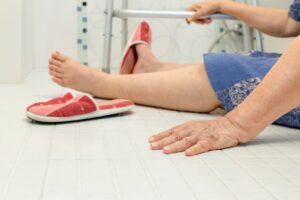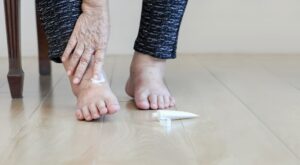Are Nursing Homes Required to Report Falls?
Abuse and Neglect, Nursing Home AbuseNursing homes are usually required to report resident falls. As part of their regulatory obligations, these facilities are mandated to maintain records of many types of incidents, including falls.
Reporting falls is crucial for several reasons:
- It helps to ensure the well-being of residents by allowing staff to assess the circumstances surrounding the fall and provide appropriate care.
- It enables the facility to identify potential hazards or patterns contributing to falls, allowing for preventive measures.
- Reporting falls is often necessary to maintain compliance with state and federal regulations that govern nursing home operations.
Unfortunately, reporting requirements do not always prevent falls and injuries to residents.
If your loved one recently suffered injuries in a fall at a nursing home, a skilled nursing home negligence attorney in your area can help. Your lawyer can thoroughly investigate the fall circumstances and file a claim or lawsuit seeking appropriate monetary compensation and damages.
Injuries in Nursing Home Fall Incidents

In nursing homes, residents are susceptible to various types of fall injuries due to factors such as age-related frailty, medical conditions, and environmental hazards. Among the most common fall injuries that nursing home residents may experience are fractures, head injuries, and soft tissue injuries:
- Fractures, particularly of the hip, wrist, and spine, are prevalent among elderly individuals who fall. These fractures can lead to significant pain, immobility, and a decline in overall health. Hip fractures, in particular, can have severe consequences, often resulting in surgery, prolonged rehabilitation, and an increased risk of mortality.
- Head injuries are another frequent outcome of falls in nursing homes. Older adults are more vulnerable to head trauma due to changes in bone density and brain atrophy. Head injuries can range from concussions to more severe traumatic brain injuries (TBIs), potentially causing cognitive impairment, neurological deficits, and long-term disability.
- Soft tissue injuries, such as bruises, lacerations, and sprains, are also common among nursing home residents who fall. While these injuries may seem less severe than fractures or head trauma, they can still result in pain, discomfort, and complications, especially for individuals with fragile skin or underlying health conditions.
Moreover, falls in nursing homes can have psychological consequences, including fear of falling, anxiety, loss of confidence, and decreased quality of life. Older adults who experience falls may become hesitant to engage in activities or move independently, leading to decreased mobility and functional decline over time.
Common Causes of Fall Injuries at Nursing Homes
In nursing homes, fall injuries can sometimes occur due to negligence on the part of staff – or the facility itself. Several common causes of fall injuries resulting from negligence include inadequate supervision, failure to assess and address resident fall risks, understaffing, improper use of restraints, and environmental hazards.
- Inadequate supervision is a significant issue in nursing homes that can lead to preventable falls. Staff members may not be present or attentive when residents require help with mobility, toileting, or other activities. Failing to provide adequate supervision can result in residents attempting tasks beyond their abilities, using improper techniques for moving, or engaging in risky behaviors that increase the likelihood of falls.
- Failing to assess (and address) resident fall risks is another form of negligence that may contribute to fall injuries at nursing homes. Properly assessing residents’ mobility, balance, strength, and medical conditions is essential for identifying individuals with a high risk of falling. However, if nursing home staff members do not conduct these assessments regularly, residents may be vulnerable to falls.
- Understaffing is a common problem in nursing homes that may compromise resident safety and increase the risk of fall injuries. When facilities are understaffed, staff members may be stretched thin, leading to delays in responding to residents’ needs, inadequate supervision, and insufficient assistance with mobility or personal care tasks. Understaffing can also result in rushed or incomplete care, increasing the likelihood of errors and fall accidents.
- Improper use of restraints is another form of negligence that may contribute to fall injuries in nursing homes. Restraints should only be used as a last resort – and in accordance with applicable regulations and guidelines. However, if restraints are used improperly, they can increase the risk of falls by restricting residents’ movement and mobility, leading to muscle weakness, joint stiffness, and loss of balance.
- Environmental hazards, like slippery floors, inadequate lighting, cluttered pathways, and improperly maintained equipment, can also contribute to fall injuries in nursing homes. Failing to identify and correct these hazards can result in accidents and injuries that may have been preventable with proper maintenance and oversight.
How to Legally Prove that a Nursing Home is Negligent for a Fall Injury
Proving negligence in a fall injury case against a nursing home requires evidence-gathering. This evidence must demonstrate that the facility failed to uphold its duty of care to its residents.
- First, the resident (through their attorney) must show that the nursing home owed a duty of care to the resident to provide a safe environment and appropriate supervision to prevent falls. This duty of care is typically established through regulations, standards, and the facility’s policies and procedures.
- Secondly, the resident must demonstrate that the nursing home breached this duty of care by failing to take reasonable precautions to prevent the resident from falling. This may involve evidence of inadequate staffing levels, insufficient supervision, failing to conduct fall risk assessments, or failing to use appropriate preventive measures.
- Thirdly, there must be a direct link between the nursing home’s breach of duty and the resident’s fall injury. This requires evidence showing that the fall was a foreseeable consequence of the nursing home’s negligence and would not have occurred had the nursing home taken the proper precautions.
- Finally, the resident must have suffered damages due to the fall injury, such as physical injuries, pain and suffering, medical expenses, or a decline in overall health and well-being.
To legally prove nursing home negligence in a fall injury case, various types of evidence may be necessary, including:
- Medical records documenting the resident’s fall injury, including the extent of their injuries, treatment received, and prognosis.
- Incident reports by nursing home staff members detailing the fall’s circumstances, any contributing factors, and the actions taken in response to the incident.
- Witness statements from staff members, other residents, or visitors who observed the fall or were aware of conditions within the facility that may have contributed to the incident.
- Documentation of the nursing home’s policies and procedures related to fall prevention, staffing levels, resident assessments, and supervision protocols.
- Expert testimony from healthcare professionals, such as physicians, nurses, or physical therapists, regarding the standard of care expected in nursing homes and whether the facility’s actions amounted to negligence.
- Surveillance footage or photographs showing the conditions within the nursing home that may have contributed to the resident’s fall, such as environmental hazards or inadequate supervision.
By gathering and presenting compelling evidence of nursing home negligence, residents or their families can seek justice and hold facilities accountable for failing to provide a safe environment for their vulnerable loved ones.
Recovering Damages Following a Nursing Home Fall Injury

Following a nursing home fall injury, victims may be entitled to various types of compensation to address the physical, emotional, and financial consequences of their injuries. Types of available compensation may include:
- Payment of Medical Expenses – Compensation for medical expenses covers the costs associated with diagnosing, treating, and rehabilitating the injuries sustained in a fall. This may include emergency room visits, hospital stays, surgeries, medications, rehabilitation, medical equipment, and ongoing medical care.
- Pain and Suffering – Pain and suffering damages compensate victims for the physical pain, discomfort, and emotional distress endured as a result of the fall injury. This type of compensation acknowledges the intangible losses that the victim experienced, such as anxiety, depression, loss of life enjoyment, and emotional trauma.
- Loss of Consortium – In some cases, spouses or family members of nursing home fall injury victims may be entitled to compensation for the loss of companionship, care, and support resulting from the victim’s injuries. This type of compensation acknowledges the effects of the injury on the victim’s relationships and the emotional toll it takes on their loved ones.
- Punitive Damages – In cases involving egregious negligence or intentional misconduct on the part of the nursing home, victims may be awarded punitive damages in addition to compensatory damages. Punitive damages punish the wrongdoer and deter similar misconduct from facilities in the future.
- Wrongful Death Damages – If a nursing home fall injury results in the death of the victim, surviving family members may be entitled to compensation for wrongful death damages. These damages may include funeral and burial expenses, medical bills, lost financial support, and compensation for the loss of the deceased’s companionship, guidance, and support.
By pursuing compensation for nursing home fall injuries, victims and their families can seek justice and obtain the financial resources necessary to cope with various physical, emotional, and financial challenges.
Settling or Litigating a Nursing Home Negligence Case

When faced with a nursing home negligence case involving a fall injury, individuals can settle the case out of court or pursue litigation through the legal system. Both options have pros and cons, and the decision to settle or litigate depends on various factors, including the strength of the case, the extent of the fall injuries, and the parties’ preferences.
Settling a nursing home negligence case involves reaching a negotiated agreement between the victim and the nursing home or their insurance company without going to trial. Some of the pros of settling a case include:
- Faster Resolution – Settlements typically result in a quicker resolution than litigation, allowing victims to receive compensation more promptly.
- Reduced Costs – Settling a case can be less expensive than going to trial, as it avoids the costs of court fees and expert witnesses.
- Control over Outcome – Settlements allow victims to have more control over the outcome of their case and the terms of the agreement rather than leaving the decision in the hands of a judge or jury.
However, settling a case also has some potential drawbacks, including:
- Possible Lower Compensation – Settlement offers may not fully compensate victims for the extent of their injuries and losses, as insurance companies may offer lower settlements to minimize their financial liability.
- Lack of Accountability—Settlement of a case without going to trial may result in the nursing home avoiding public scrutiny and accountability for its negligence.
On the other hand, litigating a nursing home negligence case involves taking the matter to court and allowing a judge or jury to decide the outcome. Some of the pros of litigation include:
- Potential for Higher Compensation – In some cases, going to trial may result in higher compensation for the victim, as a judge or jury may award damages that more accurately reflect the full extent of the injuries and losses suffered.
- Public Accountability – Litigation brings the nursing home’s negligence to light and holds them accountable for their actions in a public forum, potentially leading to improvements in care and safety standards.
However, litigation also has some potential drawbacks, including:
- Lengthy Process – Litigation can be a lengthy and time-consuming process, involving pre-trial proceedings, court appearances, and potential appeals, which may prolong the resolution of the case.
- Uncertain Outcome – The outcome of a trial is uncertain, as it depends on the evidence presented, the arguments that the lawyers make, and the decisions of the judge or jury.
An experienced nursing home negligence attorney can help individuals weigh the pros and cons of each option and make an informed decision that best serves their interests.
Speak with an Experienced Nursing Home Negligence Lawyer about Your Legal Matter Right Away
If you or your loved one recently suffered a fall injury in a nursing home setting, you may be eligible to recover compensation for your injuries and other related medical complications. A knowledgeable nursing home negligence lawyer in your area can safeguard your legal rights, determine your options, and pursue the compensation you deserve for your losses. Your personal injury lawyer can also represent you during all legal proceedings and aggressively advocate for your rights and interests.

Nathan Hughey, an attorney and fourth-generation South Carolinian, founded Hughey Law Firm in 2007. Before that, he spent five years defending nursing homes and insurance companies. Leveraging his experience, he now advocates for those injured or wronged by such entities, securing over $290 million in verdicts and settlements.